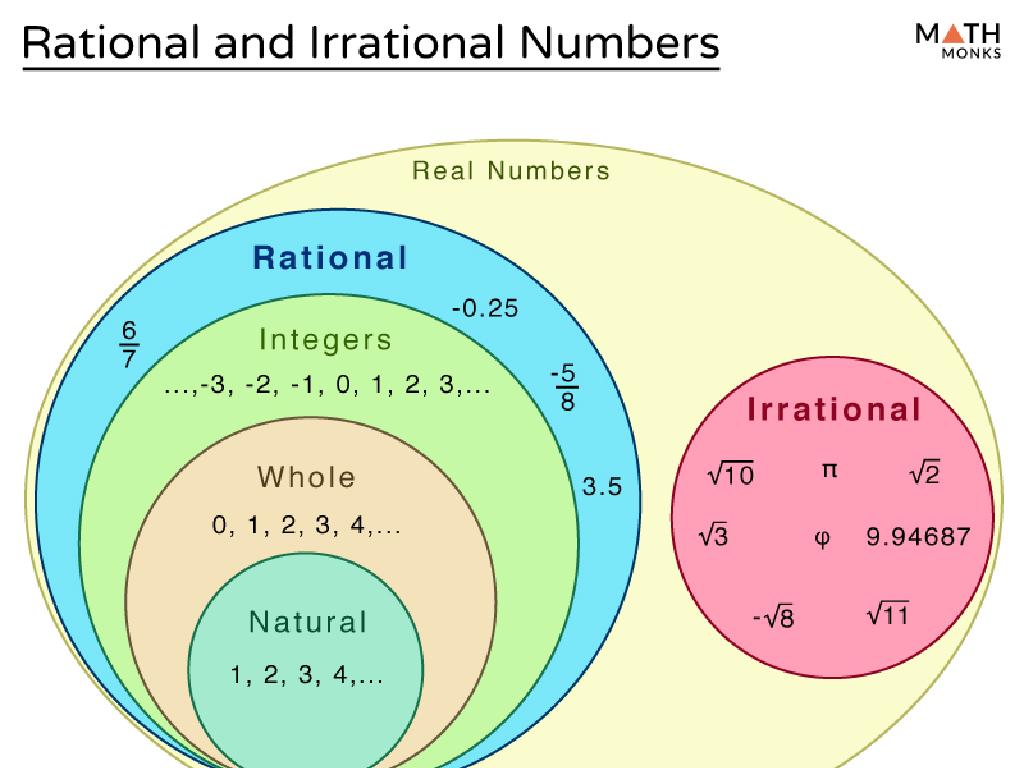Solve One-Step Equations Involving Integers
Subject: Math
Grade: Sixth grade
Topic: One-Variable Equations
Please LOG IN to download the presentation. Access is available to registered users only.
View More Content
Introduction to One-Step Equations
– Equations as a balance
– Both sides of an equation must be equal, like a balanced scale.
– Defining one-step equations
– An equation with one operation to solve, e.g., x + 3 = 7.
– Significance in math
– Mastering these builds skills for multi-step problems.
– Foundation for complex equations
|
This slide introduces the concept of one-step equations, emphasizing the analogy of a balance to help students understand that equations represent equality. It’s crucial to define one-step equations clearly, as they involve only one operation to isolate the variable. Highlight the importance of mastering one-step equations, as they are foundational for tackling more complex multi-step problems later on. Encourage students to think of equations as puzzles to solve, and ensure they grasp the concept of performing the same operation on both sides of the equation to maintain balance.
Understanding Integers in Equations
– Recap: What are integers?
– Integers include whole numbers and their negatives
– Positive vs. Negative numbers
– Positive numbers are above zero, negatives below
– Integers in real life
– Temperatures, bank balances, elevations
– Applying integers to equations
– Use integers to solve one-step equations
|
Begin with a brief review of integers, emphasizing that they consist of whole numbers, their opposites, and zero. Highlight the difference between positive and negative numbers, using a number line if necessary. Provide relatable examples of integers from everyday life, such as temperatures (above/below zero), bank account balances (deposits/withdrawals), or elevations (above/below sea level). Conclude by explaining how understanding integers is crucial for solving one-step equations, setting the stage for the next part of the lesson where students will apply this knowledge to solve mathematical problems involving integers.
Solving One-Step Equations: Addition
– Equations as a balance concept
– Example equation: x + 3 = 7
– If x + 3 equals 7, what is x?
– Isolate variable by subtraction
– Subtract 3 from both sides to find x
– Achieve balance by doing the same to both sides
– Ensures both sides remain equal
|
This slide introduces the concept of solving one-step addition equations by treating them as a balance. Emphasize that whatever operation is done to one side of the equation must also be done to the other to maintain balance. Use the example x + 3 = 7 to show how to isolate the variable x by subtracting 3 from both sides of the equation. This will result in x = 4, demonstrating the solution to the equation. Encourage students to think of the equation as a scale in equilibrium, and any changes made to one side must be replicated on the other to keep it balanced. Practice with additional examples to reinforce the concept.
Solving One-Step Equations: Subtraction
– Understanding equation balance
– Example: x – 5 = -2
– Find what ‘x’ is when 5 is subtracted to get -2
– Isolate variable: add 5
– Adding 5 to both sides gives x = 3
– Verify solution by substitution
– Substitute x with 3 to check: 3 – 5 = -2
|
This slide introduces the concept of maintaining balance in an equation while solving for an unknown variable using subtraction. Start by explaining that an equation is like a balance scale; whatever you do to one side, you must do to the other to keep it balanced. Use the example x – 5 = -2 to demonstrate how to isolate the variable by performing the inverse operation, which is adding 5 to both sides in this case. Once students find the value of x, they should substitute it back into the original equation to verify that the solution is correct. Encourage students to practice with similar equations and reinforce the concept of ‘doing the same to both sides’ to maintain balance.
Solving One-Step Equations
– Solve x + 8 = 12
– Subtract 8 from both sides to find x
– Solve x – 10 = -15
– Add 10 to both sides to find x
|
This slide is aimed at providing practice problems for students to apply their knowledge of solving one-step equations involving integers. The first example, x + 8 = 12, demonstrates how to isolate the variable by performing the inverse operation, which in this case is subtraction. Students should subtract 8 from both sides of the equation to solve for x. The second example, x – 10 = -15, requires adding 10 to both sides to find the value of x. Encourage students to work through these problems step-by-step and check their answers by substituting the value of x back into the original equation. Provide additional similar problems for students to solve independently and discuss the solutions as a class.
Class Activity: Equation Race
– Pair up and solve equations
– First to finish wins a prize
– Review solutions together
– Discuss different solving methods
– Understand one-step equations
– Reinforce concept of balancing equations
|
This activity is designed to make learning interactive and competitive. Split the class into pairs and provide each pair with a set of one-step equations involving integers. The first pair to solve all equations correctly will receive a small prize, which adds motivation and excitement to the activity. After the race, bring the class together to review and discuss the solutions. This is a crucial step to ensure that all students understand the methods used and can learn from any mistakes. Encourage students to explain their thought process and the steps they took to solve the equations. This will help reinforce the concept of balancing equations and provide a deeper understanding of solving one-step equations. Possible variations of the activity could include using different operations (addition, subtraction, multiplication, division) or incorporating negative numbers to challenge students further.
Homework and Wrap-Up: Mastering One-Step Equations
– Assign mixed one-step equation problems
– Include varying levels of difficulty
– Integers may range from simple to challenging
– Emphasize the value of practice
– Regular practice solidifies understanding
– Encourage questions and review
– Seek help if needed, review today’s lesson
|
For homework, students will be given a variety of one-step equations to solve, ensuring that there are problems of different difficulty levels to cater to the diverse skill set of the class. This will help students to become more comfortable with integers and the process of solving equations. Emphasize to students the importance of consistent practice in mastering mathematical concepts and encourage them to ask questions and review the day’s lesson if they encounter difficulties. The goal is to build confidence and proficiency in solving one-step equations involving integers.






